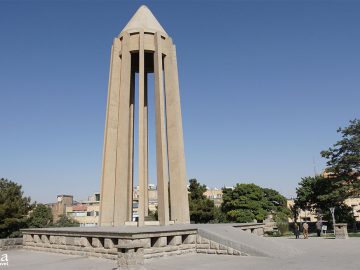
This place is the mausoleum of the great Persian Scientist Avicenna. The original monument was built in early Qajar Era and by the order of a noble lady named Negar that is said to be Fath Ali Shah’s daughter. The construct was later destroyed, and in 1950, the current monument took its place. The architecture of the place was inspired by the architecture of the time that the great scientist himself lived and after Gonbad-e Qabus which is one of the greatest Islamic constructs of Iran. while the Qabus Dome has 10 sides, this one has 12 sides that each stand for a science that Avicenna was a master of. The height of each of the 12 pillars is about 22.95, and the length of the pillars is about 117 cm in the base and 92 cm near the dome.
The architecture of the place was inspired by the architecture of the time that the great scientist himself lived and after Gonbad-e Qabus which is one of the greatest Islamic constructs of Iran.
The circular base of the mausoleum has a diameter of about 2.05 m and the height of the conical dome is 3.4 m. the whole construct is 28 m with an entrance on the east and an iwan with 30 m length and 3.15 width. A wooden door with a height of about 3.24 is the way of connection to the monuments main room.

There are two graves in this room; one belonging to Avicenna that is around 100 years old and the other is Abu Saeed Dakhdouk that was Avicenna’s friend. Avicenna was a guest in Abu Saeed’s house and lived with him in the place that today is used as their mausoleum. Above the walls, there are 40 marble stones covered with lines from Avicenna’s most famous works. There are other constructs in the garden that the mausoleum is built within; one was turned to a museum and the other to a library. Another important section of the mausoleum is the 3 m statue of Avicenna that was made by Abull Hassan Sedighi from a one-piece marble stone that is placed in the square that leads to the mausoleum.

